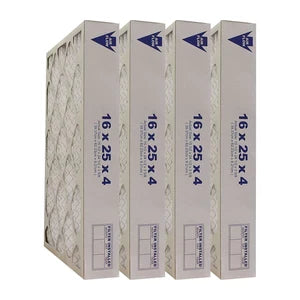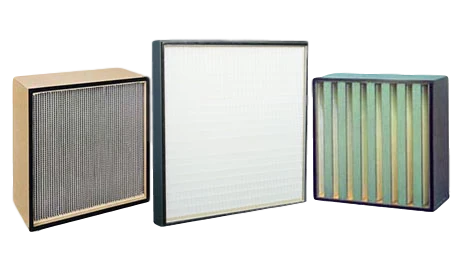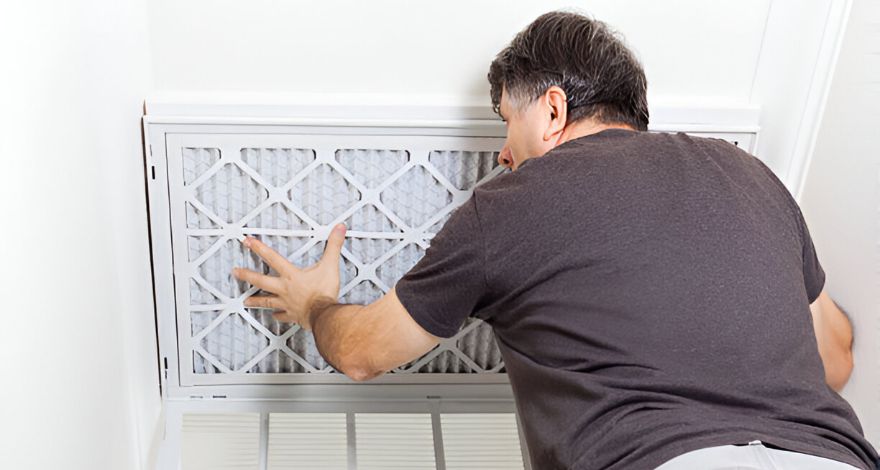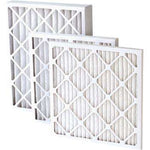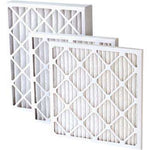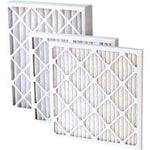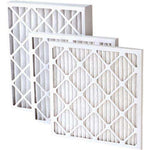Vous avez pas d'articles dans votre panier.
How Often Do I Need to Change a Geothermal Filter to Keep Air Clean and Efficient?
How often do I need to change a geothermal filter? It’s a question every homeowner with a heat pump should be asking. That’s because the answer directly impacts both air quality (IAQ) and system performance.
On average, we tell customers to plan for replacement about every three months, but no two homes are the same.
A smart geothermal furnace maintenance routine means checking your filter monthly and adjusting based on air quality, household activity, and the filter’s MERV rating.
Neglecting this simple step can lead to clogged filters, higher energy bills, and unnecessary wear on your system.
If you’re wondering how often to change a geothermal filter in Canada, here’s everything you need to know.

Why Do Geothermal Furnace Filters Matter?
Before answering “How often do I need to change a geothermal filter?”, let’s talk about the basics and why these filters matter at all.
Your geothermal furnace filter can trap dust, that’s for sure.
However, it also protects both your home’s air quality and the efficiency of your system. When you keep up with regular geothermal furnace maintenance, you:
-
Capture dust, pollen, pet dander, and mould spores before they circulate indoors
-
Allow your geothermal heat pump to move air freely
-
Maintain consistent heating and cooling throughout your home
-
Prevent dirt from building up inside ducts and system components
-
Avoid unnecessary strain that leads to higher energy bills and expensive repairs
Here’s a short story about one family who asked us, “How often do I need to change a geothermal filter?”.
They believed their geothermal unit was breaking down. The system barely cooled their home, and their monthly bills kept climbing.
After a quick inspection, we discovered the real problem: a clogged MERV 11 geothermal filter that hadn’t been changed in more than a year.
As soon as they replaced it, airflow returned, comfort improved, and their next bill was nearly 15% lower.
So, if you have doubts about the geothermal filter schedule, contact us right away.

The Role of MERV Ratings in Geothermal Filters
When homeowners ask us how often to change a geothermal filter, we always point them first to the filter’s MERV rating.
MERV stands for Minimum Efficiency Reporting Value, and it measures how effectively a filter captures airborne particles. The higher the number, the smaller the particles it can trap.
However, higher ratings can also restrict airflow if your system can’t handle them.
-
MERV 8 filters: MERV 8 furnace filters can provide basic protection. They trap common household particles such as dust, pollen, and lint. Because they don’t clog as quickly, most MERV 8 geothermal filters last up to three months.
They’re a budget-friendly choice for homes without pets or serious allergy concerns.
-
MERV 11 furnace filters: These furnace filters in Canada can capture finer contaminants like pet dander, mould spores, and some smaller allergens.
If you have pets or live in a humid area, a MERV 11 geothermal filter can offer a balance between air quality and system performance. Typically, you’d replace these furnace filters in Canada every two to three months.
-
MERV 13 filters: Many experts believe that these are the best air filters for furnace. That’s because MERV 13 furnace filters can block the smallest particles, including smoke, bacteria, and some viruses.
While a MERV 13 geothermal furnace filter offers the highest indoor air quality, it also fills up faster.
Most of the time, you’d need to replace a MERV 13 filter every one to two months. We recommend them for homes with allergy sufferers or in areas with poor outdoor air quality.
Just remember that not every geothermal heat pump can handle the airflow resistance of MERV 13. If you have more questions about a geothermal heat pump MERV rating, contact experts.
In sum, when it comes to answering “How often do I need to change a geothermal filter?”, remember that it depends.
For proper geothermal furnace maintenance, always check your system’s manual or consult an expert before upgrading. If you install a rating that’s too high, it can strain the blower motor and reduce efficiency, not improve it.

4 Common Factors That Can Affect the Geothermal Filter Schedule
How often do I need to change a geothermal filter? Usually, you can find all answers in the manufacturer's guidelines.
However, your household conditions ultimately decide how often you should replace a geothermal filter.
So, how often to change a geothermal filter?
Well, we noticed the following four everyday factors that usually shorten a furnace filter’s life and demand more frequent checks: including pets, renovation work, and individual lifestyles.
-
Pets: Cats and dogs shed fur and dander that can circulate through your home’s air. Even if you vacuum daily, these particles quickly clog filters.
In multi-pet households, filters often fill up weeks earlier than in pet-free homes.
-
Renovation work: When it comes to geothermal furnace maintenance, remember that any renovation work, like drywall installation, can create fine dust. This dust can then linger long after the project ends.
This dust can saturate a geothermal furnace filter within weeks and force your system to work harder than it should.
-
Location: Where you live directly impacts air quality. Rural homes with gravel driveways stir up extra dust each time a car pulls in.
Urban homes near busy roads or industrial zones often draw in outdoor pollutants and exhaust particles. Both situations cause filters to clog faster.
-
Family size and lifestyle: More people in the home means more movement, more laundry, and more cooking, all of which release particles into the air.
And naturally, a household of six will place more demand on a filter than a single-person home.
How often do I need to change a geothermal filter? It depends on any of the factors above.
And because these factors vary so much, we always recommend homeowners check their geothermal air filter monthly.
You may not need to replace it every time, but a quick inspection ensures you catch problems before they turn into higher energy bills or comfort issues.

5 Fool-Proof Dirty Geothermal Filter Symptoms to Look Out For
Many homeowners don’t notice a clogged geothermal filter until their system starts showing signs of stress.
If you know what to look for, you can catch the problem early and avoid costly repairs. Watch for these common dirty geothermal filter symptoms below:
-
Reduced airflow from vents: Place your hand in front of a supply vent while the system runs. If the air feels weak compared to usual, the filter may be blocking proper airflow.
-
Whistling sound from the return grille: When a filter becomes clogged, the system struggles to pull air through. This strain often creates a faint whistling or whooshing noise around the return grille.
-
Uneven heating or cooling: Rooms farthest from the unit may feel hotter or colder than others. When the airflow isn’t optimal, it can prevent healthy air from reaching every corner of your home evenly.
-
Rising energy bills: If your bills climb even though you haven’t changed thermostat settings, the system may be working overtime to push air through a dirty filter.
-
Dust buildup on furniture: If you’ve been noticing dust collecting faster on tables, shelves, or electronics, it could be a sign of a clogged filter.
When you’re dealing with clogs, know that they can’t trap particles effectively. This means that you’ll end up with more dust indoors and on your favourite furniture.
How often do I need to change a geothermal filter? As soon as you notice any of these warning signs, check your geothermal filter right away.
A quick replacement often restores airflow, lowers energy use, and improves comfort almost immediately.
How To Check a Geothermal Filter?
While it’s always best to talk to an expert, usually you don’t need special tools to check a geothermal filter.
Follow these four beginner-friendly steps closely to learn how to check a geothermal filter easily.
-
Step 1: Turn off your system: Always switch off your geothermal furnace or heat pump before removing the filter. This keeps you safe and prevents the system from pulling in unfiltered air.
-
Step 2: Locate and remove the filter: Find the filter slot near the return air duct or inside the unit. Slide the filter out carefully so dust doesn’t scatter.
-
Step 3: Hold the filter up to the light: A clean filter allows light to pass through. If the media looks dark, clogged, or blocks most of the light, it’s time to replace it.
-
Step 4: Confirm the size: Look at the dimensions printed on the filter frame. Note both the nominal size (e.g., 16x25x1) and the actual size (slightly smaller, like 15½ x 24½ x ¾).
Remember this: Geothermal filter dimensions can vary, and ordering the wrong size leads to a poor fit and reduced filtration.
Always check your filter monthly to catch any problems before they affect comfort or energy efficiency. Even if you don’t replace it every time, this quick habit keeps your geothermal furnace running smoothly.

Geothermal Filter Cost and Value
Homeowners often ask about geothermal filter cost, and the truth is that prices vary based on size, MERV rating, and pack quantity.
For example, a MERV 11 furnace filter typically costs more than a MERV 8, but the added protection against allergens and finer particles makes it worthwhile in many households.
When you compare the modest price of a filter to the cost of repairing or replacing a compressor, the value becomes clear.
Many homeowners find that buying filters in multi-packs saves money in the long run, especially when sourcing from trusted suppliers.
United Filter, for instance, offers competitive pricing on premium-quality discount furnace filters, so it’s easier to stay on schedule without overspending.
So, if you’re wondering “How often do I need to change a geothermal filter?” and you’re worried about the price, you can relax. You’ll find the highest-quality, yet affordable at United Filter.
Choosing the Best Air Filters for a Geothermal System
Choose a geothermal filter that balances clean air with proper airflow.
A MERV 13 filter captures the smallest particles, but remember that some systems can’t handle the restriction. Many units perform best with MERV 11 furnace filters, which trap allergens without overworking the blower.
To get the right fit, always match the filter size and rating to your heat pump’s requirements.
At United Filter, you can find both standard and custom size geothermal filters that can meet those needs.
Where to Buy Geothermal Filters in Canada and the USA?
If you need geothermal furnace filters in Canada or the United States, you can order directly through United Filter. We stock standard and custom filters, including 1” to 5” sizes, with fast shipping across North America.
By choosing aftermarket filters, you save money without sacrificing quality compared to OEM brands like Honeywell or Lennox.

Conclusion: How Often to Change a Geothermal Filter?
So, how often do you need to change a geothermal filter? The safest approach is to check monthly and replace every one to three months, depending on your system’s MERV rating and household factors.
Staying on top of replacements prevents dirty geothermal filter symptoms, keeps energy bills low, and extends system life.
When you treat filter replacement as an essential part of geothermal furnace maintenance, you protect your home’s comfort and air quality.
If you’re ready to order fresh filters, United Filter makes it easy to find the right fit for your system with reliable shipping across Canada and the USA.
How Often Do I Need to Change a Geothermal Filter to Keep Air Clean and Efficient?
How often do I need to change a geothermal filter? It’s a question every homeowner with a heat pump should be asking. That’s because the answer directly impacts both air quality (IAQ) and system performance.
On average, we tell customers to plan for replacement about every three months, but no two homes are the same.
A smart geothermal furnace maintenance routine means checking your filter monthly and adjusting based on air quality, household activity, and the filter’s MERV rating.
Neglecting this simple step can lead to clogged filters, higher energy bills, and unnecessary wear on your system.
If you’re wondering how often to change a geothermal filter in Canada, here’s everything you need to know.

Why Do Geothermal Furnace Filters Matter?
Before answering “How often do I need to change a geothermal filter?”, let’s talk about the basics and why these filters matter at all.
Your geothermal furnace filter can trap dust, that’s for sure.
However, it also protects both your home’s air quality and the efficiency of your system. When you keep up with regular geothermal furnace maintenance, you:
-
Capture dust, pollen, pet dander, and mould spores before they circulate indoors
-
Allow your geothermal heat pump to move air freely
-
Maintain consistent heating and cooling throughout your home
-
Prevent dirt from building up inside ducts and system components
-
Avoid unnecessary strain that leads to higher energy bills and expensive repairs
Here’s a short story about one family who asked us, “How often do I need to change a geothermal filter?”.
They believed their geothermal unit was breaking down. The system barely cooled their home, and their monthly bills kept climbing.
After a quick inspection, we discovered the real problem: a clogged MERV 11 geothermal filter that hadn’t been changed in more than a year.
As soon as they replaced it, airflow returned, comfort improved, and their next bill was nearly 15% lower.
So, if you have doubts about the geothermal filter schedule, contact us right away.

The Role of MERV Ratings in Geothermal Filters
When homeowners ask us how often to change a geothermal filter, we always point them first to the filter’s MERV rating.
MERV stands for Minimum Efficiency Reporting Value, and it measures how effectively a filter captures airborne particles. The higher the number, the smaller the particles it can trap.
However, higher ratings can also restrict airflow if your system can’t handle them.
-
MERV 8 filters: MERV 8 furnace filters can provide basic protection. They trap common household particles such as dust, pollen, and lint. Because they don’t clog as quickly, most MERV 8 geothermal filters last up to three months.
They’re a budget-friendly choice for homes without pets or serious allergy concerns.
-
MERV 11 furnace filters: These furnace filters in Canada can capture finer contaminants like pet dander, mould spores, and some smaller allergens.
If you have pets or live in a humid area, a MERV 11 geothermal filter can offer a balance between air quality and system performance. Typically, you’d replace these furnace filters in Canada every two to three months.
-
MERV 13 filters: Many experts believe that these are the best air filters for furnace. That’s because MERV 13 furnace filters can block the smallest particles, including smoke, bacteria, and some viruses.
While a MERV 13 geothermal furnace filter offers the highest indoor air quality, it also fills up faster.
Most of the time, you’d need to replace a MERV 13 filter every one to two months. We recommend them for homes with allergy sufferers or in areas with poor outdoor air quality.
Just remember that not every geothermal heat pump can handle the airflow resistance of MERV 13. If you have more questions about a geothermal heat pump MERV rating, contact experts.
In sum, when it comes to answering “How often do I need to change a geothermal filter?”, remember that it depends.
For proper geothermal furnace maintenance, always check your system’s manual or consult an expert before upgrading. If you install a rating that’s too high, it can strain the blower motor and reduce efficiency, not improve it.

4 Common Factors That Can Affect the Geothermal Filter Schedule
How often do I need to change a geothermal filter? Usually, you can find all answers in the manufacturer's guidelines.
However, your household conditions ultimately decide how often you should replace a geothermal filter.
So, how often to change a geothermal filter?
Well, we noticed the following four everyday factors that usually shorten a furnace filter’s life and demand more frequent checks: including pets, renovation work, and individual lifestyles.
-
Pets: Cats and dogs shed fur and dander that can circulate through your home’s air. Even if you vacuum daily, these particles quickly clog filters.
In multi-pet households, filters often fill up weeks earlier than in pet-free homes.
-
Renovation work: When it comes to geothermal furnace maintenance, remember that any renovation work, like drywall installation, can create fine dust. This dust can then linger long after the project ends.
This dust can saturate a geothermal furnace filter within weeks and force your system to work harder than it should.
-
Location: Where you live directly impacts air quality. Rural homes with gravel driveways stir up extra dust each time a car pulls in.
Urban homes near busy roads or industrial zones often draw in outdoor pollutants and exhaust particles. Both situations cause filters to clog faster.
-
Family size and lifestyle: More people in the home means more movement, more laundry, and more cooking, all of which release particles into the air.
And naturally, a household of six will place more demand on a filter than a single-person home.
How often do I need to change a geothermal filter? It depends on any of the factors above.
And because these factors vary so much, we always recommend homeowners check their geothermal air filter monthly.
You may not need to replace it every time, but a quick inspection ensures you catch problems before they turn into higher energy bills or comfort issues.

5 Fool-Proof Dirty Geothermal Filter Symptoms to Look Out For
Many homeowners don’t notice a clogged geothermal filter until their system starts showing signs of stress.
If you know what to look for, you can catch the problem early and avoid costly repairs. Watch for these common dirty geothermal filter symptoms below:
-
Reduced airflow from vents: Place your hand in front of a supply vent while the system runs. If the air feels weak compared to usual, the filter may be blocking proper airflow.
-
Whistling sound from the return grille: When a filter becomes clogged, the system struggles to pull air through. This strain often creates a faint whistling or whooshing noise around the return grille.
-
Uneven heating or cooling: Rooms farthest from the unit may feel hotter or colder than others. When the airflow isn’t optimal, it can prevent healthy air from reaching every corner of your home evenly.
-
Rising energy bills: If your bills climb even though you haven’t changed thermostat settings, the system may be working overtime to push air through a dirty filter.
-
Dust buildup on furniture: If you’ve been noticing dust collecting faster on tables, shelves, or electronics, it could be a sign of a clogged filter.
When you’re dealing with clogs, know that they can’t trap particles effectively. This means that you’ll end up with more dust indoors and on your favourite furniture.
How often do I need to change a geothermal filter? As soon as you notice any of these warning signs, check your geothermal filter right away.
A quick replacement often restores airflow, lowers energy use, and improves comfort almost immediately.
How To Check a Geothermal Filter?
While it’s always best to talk to an expert, usually you don’t need special tools to check a geothermal filter.
Follow these four beginner-friendly steps closely to learn how to check a geothermal filter easily.
-
Step 1: Turn off your system: Always switch off your geothermal furnace or heat pump before removing the filter. This keeps you safe and prevents the system from pulling in unfiltered air.
-
Step 2: Locate and remove the filter: Find the filter slot near the return air duct or inside the unit. Slide the filter out carefully so dust doesn’t scatter.
-
Step 3: Hold the filter up to the light: A clean filter allows light to pass through. If the media looks dark, clogged, or blocks most of the light, it’s time to replace it.
-
Step 4: Confirm the size: Look at the dimensions printed on the filter frame. Note both the nominal size (e.g., 16x25x1) and the actual size (slightly smaller, like 15½ x 24½ x ¾).
Remember this: Geothermal filter dimensions can vary, and ordering the wrong size leads to a poor fit and reduced filtration.
Always check your filter monthly to catch any problems before they affect comfort or energy efficiency. Even if you don’t replace it every time, this quick habit keeps your geothermal furnace running smoothly.

Geothermal Filter Cost and Value
Homeowners often ask about geothermal filter cost, and the truth is that prices vary based on size, MERV rating, and pack quantity.
For example, a MERV 11 furnace filter typically costs more than a MERV 8, but the added protection against allergens and finer particles makes it worthwhile in many households.
When you compare the modest price of a filter to the cost of repairing or replacing a compressor, the value becomes clear.
Many homeowners find that buying filters in multi-packs saves money in the long run, especially when sourcing from trusted suppliers.
United Filter, for instance, offers competitive pricing on premium-quality discount furnace filters, so it’s easier to stay on schedule without overspending.
So, if you’re wondering “How often do I need to change a geothermal filter?” and you’re worried about the price, you can relax. You’ll find the highest-quality, yet affordable at United Filter.
Choosing the Best Air Filters for a Geothermal System
Choose a geothermal filter that balances clean air with proper airflow.
A MERV 13 filter captures the smallest particles, but remember that some systems can’t handle the restriction. Many units perform best with MERV 11 furnace filters, which trap allergens without overworking the blower.
To get the right fit, always match the filter size and rating to your heat pump’s requirements.
At United Filter, you can find both standard and custom size geothermal filters that can meet those needs.
Where to Buy Geothermal Filters in Canada and the USA?
If you need geothermal furnace filters in Canada or the United States, you can order directly through United Filter. We stock standard and custom filters, including 1” to 5” sizes, with fast shipping across North America.
By choosing aftermarket filters, you save money without sacrificing quality compared to OEM brands like Honeywell or Lennox.

Conclusion: How Often to Change a Geothermal Filter?
So, how often do you need to change a geothermal filter? The safest approach is to check monthly and replace every one to three months, depending on your system’s MERV rating and household factors.
Staying on top of replacements prevents dirty geothermal filter symptoms, keeps energy bills low, and extends system life.
When you treat filter replacement as an essential part of geothermal furnace maintenance, you protect your home’s comfort and air quality.
If you’re ready to order fresh filters, United Filter makes it easy to find the right fit for your system with reliable shipping across Canada and the USA.
